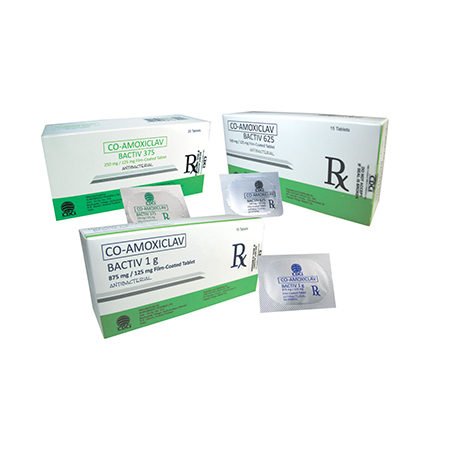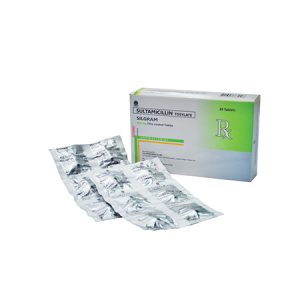Description
The Cathay Drug Co., Inc.
PRODUCT DESCRIPTION
Co-amoxiclav is an antibacterial combination of amoxicillin (as sodium) and the beta-lactamase inhibitor, clavulanic acid (as potassium clavulanate).
BACTIV 375: White oval shaped film – coated, debossed with “A” on one side and “63” on the other side.
BACTIV 625: White oval shaped film – coated, debossed with “A” on one side and “63” on the other side.
BACTIV 1 g: White colored capsule shaped film – coated, debossed with “A” on one side and with a score line between “6” and “5” on the other side.
FORMULATION
BACTIV 375 mg Film – Coated Tablet contains
Amoxicillin Trihydrate (as Trihydrate) Ph. Eur. …………………. 250 mg
Clavulanic acid (as Potassium clavulanate) …………………….. 125 mg
BACTIV 625 mg Film – Coated Tablet contains
Amoxicillin Trihydrate (as Trihydrate) Ph. Eur. …………………. 500 mg
Clavulanic acid (as Potassium clavulanate) …………………….. 125 mg
BACTIV 1 g Film – Coated Tablet contains
Amoxicillin Trihydrate (as Trihydrate) Ph. Eur. …………………. 875 mg
Clavulanic acid (as Potassium clavulanate) …………………….. 125 mg
PHARMACOLOGICAL PROPERTIES:
Pharmacokinetic Properties
The pharmacokinetics of the two components of Co-Amoxiclav (BACTIV) is closely matched. Peak serum levels of both occur about one hour after oral administration. Absorption of Co-Amoxiclav (BACTIV) optimized at the start of a meal. Both clavulanate and amoxicillin have low levels of serum binding; about 70% remains free in the serum.
Doubling the dosage of Co-Amoxiclav (BACTIV) approximately doubles the serum levels achieved.
Pharmacodynamic Properties
Bacterial enzymes that destroy the antibiotic before it can act on the pathogen cause resistance to many antibiotics. The clavulanate in Co-Amoxiclav (BACTIV) anticipates this defense mechanism by blocking the β-lactamase enzymes thus rendering the organisms sensitive to amoxicillin’s rapid bactericidal effects at concentrations readily attainable in the body.
Clavulanate by itself has little antibacterial activity: however, in association with amoxicillin as Co-Amoxiclav (BACTIV), it produces an antibiotic agent of broad spectrum with wide application in hospital and general practice. Co-Amoxiclav (BACTIV) is bactericidal to wide range of organisms including:
Gram positive
Enterococcus faecalis*, Enterococcus faecium*, Streptococcus pneumonia, Streptococcus pyogens, Streptococcus viridans, Staphylococcus aureus*, Coagulase negative staphylococci* (including Staphylococcus epidermidis*), Corynebacterium species, Bacillus anthracis, Listeria monocytogenes,
Anaerobes: Clostridium species, Peptococcus species, Peptostreptococcus.
Gram-negative
Aerobes: Haemophilus influenza*, Moraxella catarrhalis* (Branhamella catarrhalis), Escherichia coli*, Proteus mirabilis*, Proteus vulgaris*, Klebsiella species*, Salmonella species*, Shigella species*, Bordetella pertussis, Brucella species, Neisseria gonorrheae*, Neisseria meningitides*, Vibrio cholera, Pasteurella multocida.
Anaerobes: Bacteroides species* including B. fragilis.
* Some members of these species of bacteria produce β-lactamase, rendering them sensitive to amoxicillin alone.
CLINICAL PARTICULARS
Therapeutic Indications
Co-Amoxiclav (BACTIV) is an antibiotic agent with a broad spectrum of activity against the commonly occurring bacterial pathogens in general practice and hospital. The β-lactamase inhibitory action of clavulanate extends the spectrum of amoxicillin to embrace a wider range of organisms, including many resistant to other -lactam antibiotics.
Co-Amoxiclav (BACTIV) oral preparations are indicated for short-term treatment of bacterial infections at the following sites when amoxicillin resistant 6-lactamase-producing strains are suspected as the cause. In other situations, amoxicillin alone should be considered.
- Upper Respiratory Tract Infections (including ENT) in particular sinusitis, otitis media, recurrent tonsillitis. These infections are often caused by Streptococcus pneumoniae, Haemophilus influenza*, Moraxella catarrhalis* and Streptococcus pyogens.
- Lower Repiratory Tract Infections in particular acute exacerbations of chronic bronchitis (especially if considered severe), bronchopneumonia. These infections are often caused by Streptococcus pneumoniae, Haemophilus influenza*, Moraxella catarrhalis*.
- Genito-urinary Tract and Abdominal Infections in particular cystitis (especially when recurrent or complicated — excluding prostatitis), septic abortion, pelvic or puerperal sepsis and intra-abdominal sepsis. These infections are often caused by Enterobacteriaceae* (mainly Escherichia coli*), Staphylococcus saprophyticus, Enterococcus species.*
- Skin and Soft Tissue Infections in particular cellulitis, animal bites and severe dental abscess with spreading cellulitis. These infections are often caused by Stapylococcus aureus*, Streptococcus pyogenes and Bacteroides species.’
*Some members of these species of bacteria produce 6-lactamase, rendering them insensitive to amoxicillin alone.
Mixed infections caused by amoxicillin-susceptible organisms in conjunction with Co-Amoxiclav-susceptible β-lactamase-producing organisms may be treated with Co-Amoxiclav (BACTIV). These infections should not require the addition of another antibiotic resistant to β-lactamases.
DOSAGE AND MODE OF ADMINISTRATION
Since both the 375 mg, 625 mg and 1 g tablets of Co-Amoxiclav (BACTIV) contain the same amount of Clavulanic acid (125 mg, as the potassium salt), two 375 mg tablets of Co-Amoxiclav (BACTIV 375) are not equivalent to one 625 mg tablet of Co-Amoxiclav (BACTIV 625); therefore, two 375 mg tablets of Co-Amoxiclav (BACTIV 375) should not be substituted for one 625 mg tablet of Co-Amoxiclav (BACTIV 625).
Adults
The usual adult dose is one 625 mg tablet of Co-Amoxiclav (BACTIV 625) every 12 hours or one 375 mg tablet of Co-Amoxiclav (BACTIV 375) every 8 hours.
For more severe infections and infections of the respiratory tract, the dose should be one 1 g tablet of Co-Amoxiclav (BACTIV 1 g) every 12 hours or one 625 mg tablet of Co-Amoxiclav (BACTIV 625) every 8 hours.
Patients with impaired renal function do not generally require a reduction in dose unless the impairment is severe. Severely impaired patients with a glomerular filtration rate of <30 mUmin should not receive the 1 g tablet. Patients with a glomerular filtration rate of 10 to 30 mL/min should receive 625 mg or 375 mg every 12 hours, depending on the severity of the infection. Patients with less than 10 mL/min glomerular filtration rate should receive 625 mg or 375 mg every 24 hours depending on the severity of the infection.
Hemodialysis patients should receive 625 mg or 375 mg every 24 hours, depending on the severity of the infection. They should receive an additional dose both during and at the end of dialysis.
Hepatically impaired patients should be dosed with caution and hepatic function monitored at regular intervals.
Pediatric Patients
Pediatric patients weighing 40 kg or more should be dosed according to the adult recommendations. Due to the different amoxicillin to Clavulanic acid ratios in the 375 mg tablet of Co-Amoxiclav (BACTIV 375) versus the 312.5 mg chewable tablet of Co-Amoxiclav, the 375 mg tablet of Co-Amoxiclav (BACTIV 375) should not be used until the pediatric patient weighs at least 40 kg or more.
Administration
Co-Amoxiclav (BACTIV) may be taken without regard to meals; however, absorption of clavulanate potassium is enhanced when Co-Amoxiclav (BACTIV) is administered at the start of a meal.
To minimize the potential for gastrointestinal intolerance, Co-Amoxiclav (BACTIV) should be taken at the start of a meal.
CONTRAINDICATIONS
- Penicillin hypersensitivity. Attention should be paid to possible cross-sensitivity with other P-lactam antbiotics, e.g. cephalosporins.
- A previous history of Co-Amoxiclav (BACTIV) or penicillin-associated jaundice/ hepatic dysfunction.
SPECIAL WARNINGS AND PRECAUTIONS
Changes in liver function have been observed in some patients receiving Co-Amoxiclav (BACTIV). The clinical significance of these changes is uncertain but Co-Amoxiclav (BACTIV) should be used with caution in patients with evidence of hepatic dysfunction.
Cholestatic jaundice, which may be severe, but is usually reversible, has been reported rarely. Signs and symptoms may not become apparent for several weeks after treatment has ceased.
In patients with renal impairment, dosage should be adjusted according to the degree of impairment.
In patients with reduced urine output, crystalluria has been observed very rarely, predominantly with parenteral therapy, during the administration of high doses of amoxicillin, it is advisable to maintain adequate fluid intake and urinary output in order to reduce the possibility of amoxicillin crystalluria.
Serious and occasionally fatal hypersensitivity (anaphylactoid) reactions have been reported in patients on penicillin therapy. These reactions are more likely to occur in individuals with a history of penicillin hypersensitivity. Erythematous rashes have been associated with glandular fever in patients receiving amoxicillin.
Prolonged use may also occasionally result in overgrowth of non-susceptible organisms.
INTERACTIONS
Prolongation of bleeding time and prothrombin time may occur in some patients receiving Co-Amoxiclav (BACTIV). This should be used with care in patients on anti-coagulation therapy.
PREGNANCY AND LACTATION
In women with preterm, premature rupture of the fetal membrane, it was reported that prophylactic treatment with Co-Amoxiclav (BACTIV) may be associated with an increased risk of necrotizing enterocolitis in neonates. As with all medicines, use should be avoided in pregnancy, especially during the first trimester, unless considered essential by the physician. Co-Amoxiclav (BACTIV) may be administered during the period of lactation. With the exception of the risk of sensitisation, associated with the excretion of trace quantities in breast milk, there are no known detrimental effects for the breast-fed infant.
EFFECTS ON ABILITY TO DRIVE AND USE MACHINES
None known.
ADVERSE EFFECTS
Adverse effects are uncommon and mainly of a mild and transitory nature.
Gastrointestinal
Diarrhea, indigestion, nausea, vomiting and mucocutaneous candidiasis occur. Antibiotic-associated colitis (including pseudomembranous colitis and hemorrhagic colitis) occur rarely. Nausea, although uncommon, is more often associated with higher oral dosages. If gastrointestinal adverse effects occur with oral therapy they may be reduced by taking Co-Amoxiclav (BACTIV) at the start of meals.
Superficial tooth discoloration occurs rarely. It can usually be removed by brushing.
Renal
Interstitial nephritis and hematuria occur rarely. Crystalluria also occurs.
Genito-urinary
Vaginal itching, soreness and discharge may occur.
Hepatic effects
Moderate. and asymptomatic rises in AST and/or ALT and alkaline phosphatases occur occasionally. Hepatitis and cholestatic jaundice occurs rarely. These hepatic reactions occurs more commonly with Co-Amoxiclav (BACTIV) that with other penicillins.
Hepatic events have been reported predominantly in males and elderly patients, particularly those over 65 years. The risk increases with duration of treatment longer than 14 days. These reactions may occurs very rarely in children.
Signs and symptoms usually occurs during or shortly after treatment but in some cases may not occur until several weeks after treatment has ended. Hepatic reactions are usually reversible but they may be severe and very rarely, death occurs.
Hypersensitivity reactions
Urticarial and erythernatous skin rashes sometimes occurs. Rarely erythema multiforme, Stevens-Johnson syndrome, toxic epidermal necrolysis, bullous exfoliative dermatitis, acute generalized exanthematous pustulosis (AGEP), serum sickness-like syndrome and hypersensitivity vasculitis occurs. Treatment should be discontinued if one of these disorders occurs. Similarly with other 3-lactam antibiotics angioedema and anaphylaxis occurs. Interstitial nephritis can occur rarely.
Hematological effects
As with other p-lactam, transient leucopenia (including neutropenia and agranulocytosis), thrombocytopenia and hemolytic anemia occur rarely. Prolongation of bleeding time and prothrombin time also occurs rarely.
CNS effects
CNS effects occurs rarely. These include reversible hyperactivity, dizziness, headache and convulsions. Convulsions may occur with impaired renal function or in those receiving high doses.
OVERDOSAGE
Gastrointestinal symptoms and disturbance of the fluid and electrolyte balance may be evident. They may be treated symptomatically with attention to the water electrolyte balance. Co-Amoxiclav (BACTIV) may be removed from the circulation by hemodialysis. Amoxicillin crystalluria, may lead to renal failure.
CAUTION
Foods, Drugs, Devices and Cosmetics Act prohibits dispensing without prescription.
STORAGE
Store at temperatures not exceeding 30°C. Protect from moisture
Manufactured by
AUROBINDO PHARMA LIMITED (UNIT XII)
Survey Number 314, Bachupally (Village), Quthbullapur (Mandel), R.R District, Hyderabad, Telangana State, 500 090, India
Market Authorization Holder
The Cathay Drug Co., Inc.
2/F Vernida 1 Condominium, 120 Amorsolo St., Legaspi Village, Makati City, Philippines
Date of Revision: July 2019






Reviews
There are no reviews yet.